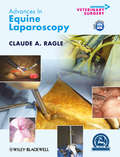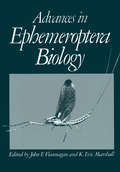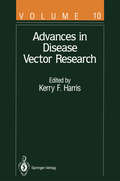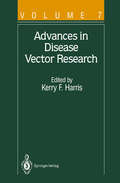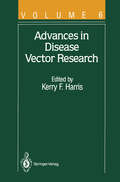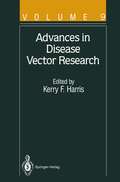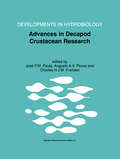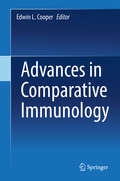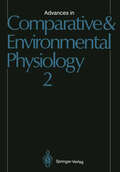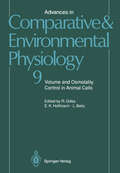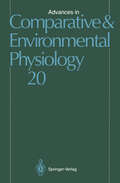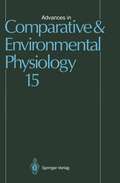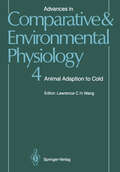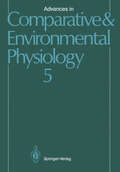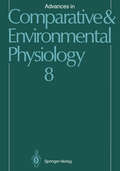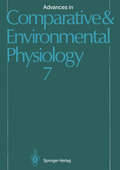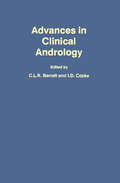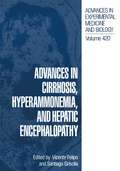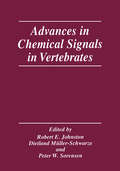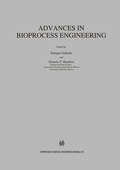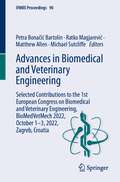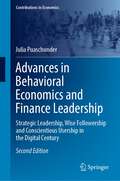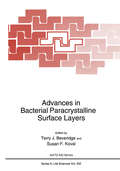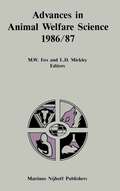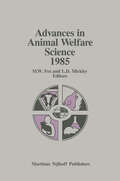- Table View
- List View
Advances in Equine Laparoscopy (AVS Advances in Veterinary Surgery)
by Claude A. RaglePart of the Advances in Veterinary Surgery series copublished with the ACVS Foundation and Wiley-Blackwell, Advances in Equine Laparoscopy presents a state-of-the-art reference on laparoscopic skills and procedures in the horse. Chapters are written by the leading experts in the field, and each section includes a practical review of the published literature. Encompassing instrumentation, basic principles, and specific techniques, Advances in Equine Laparoscopy offers an up-to-date, reliable resource for comprehensive information about equine laparoscopy. This current, well-referenced text begins with a section on the fundamentals of laparoscopy, then moves into sections on the clinical application of laparoscopic techniques in the standing or recumbent horse. A companion website offers eight video clips demonstrating selected procedures at www.wiley.com/go/ragle. Advances in Equine Laparoscopy is an invaluable guide for equine surgical specialists and equine clinicians interested in laparoscopic techniques.
Advances in Disease Vector Research (Advances in Disease Vector Research #10)
by El Desouky Ammar Y. Antignus T. R. Burkot E. P. Camargo Y. Chinzei S. Cohen D. Gonsalves P. M. Graves H. H. Hagedorn R. Hull E. I. Korenberg Yu. V. Kovalevskii G.W. Otim-Nape M. K. Shaw A. J. Shelley W. J. Tabachnick DeMar Taylor J. M. Thresh F. G. Wallace S. D. Yeh A. S. YoungVolume 10 of Advances in Disease Vector Research consists of seven chapters on vectors that affect human or animal health and six chapters on plant pathogens and their vectors. In Chapter 1, Yasuo Chinzei and DeMar Taylor discuss hormonal regulation of vitellogenesis in ticks. Many blood sucking insects and ticks transmit pathogens by engorgement, which induces vitellogenesis and oviposition in adult animals. To investigate the pathogen transmission mechanism in vector animals, information on the host physiological and endocrinological conditions after engorgement is useful and important because pathogen development or proliferation occurs in the vector hosts at the same time as the host reproduction. Chinzei and Taylor have shown that in ticks, juvenile hormone (JH) is not involved in the endocrinological processes inducing vitellogenin biosynthesis. Synganglion (tick brain) factor(s) (vitellogenesis inducing factor, VIF) is more important to initiate vitellogenesis after engorgement, and ecdysteroids are also related to induction of vitellogenin synthesis. In their chapter, based mainly on their own experimental data, the authors discuss the characterization of main yolk protein, vitellogenin (Vg) , biosynthesis and processing in the fat body, and hormonal regulation of Vg synthesis in tick systems, including ixodid and argasid ticks.
Advances in Disease Vector Research (Advances in Disease Vector Research #7)
by Christopher J. Andrews Richard H. Bagnall Nick Carter Claude Chastel John R. DeLoach Karen S. Gibb Richard Harrington Ian Humphery-Smith Ian Maudlin John W. Randles Ramesh C. Sinha George SpatesAdvances in Disease Vector Research (Advances in Disease Vector Research #6)
by S. Barbagallo M. R. Brown W. Burgdorfer F. H. Collins V. Finnerty D. A. Golino S. F. Hayes H. Hibino A. O. Lea G. P. Martelli J. Nedelman G. N. Oldfield S. M. Paskewitz R. T. Plumb A. H. Purcell B. Raccah C. N. Roistacher C. E. Taylor R. D. WardI think the reader will agree that we have attained a good balance in Volume 6 between human-or animal-host and plant-host-related topics from outstanding research scientists. In Chapter 1, Frank Collins, Susan Paskewitz, and Victoria Finnerty explore the potential of recombinant DNA technology to distinguish indi vidual species and to establish phylogenetic relationships among member species in the Anopheles gambiae species complex, which includes the principal malaria vectors. Currently, relatively little is known about these morphologically identical species that are sympatric over most of their range but are not always equally involved in malaria transmission. With respect to individual species identification, the researchers have thus far described two DNA fragments, derived from the ribosomal DNA interge nic spacer region, that reliably distinguish five species in the complex by means of an RFLP visualized on a Southern blot. They have also described other species-specific fragments derived from a ribosomal DNA intron that could form the basis for a rapid dot blot assay. With respect to the phylogenetic relationships among member species in the complex, Collins, Paskewitz, and Finnerty focus on a comparison at the level of restriction site mapping and Southern analysis of the rDNA intergenic spacer regions. As expected, the two spacer regions near the coding region junctions are well conserved among the species, whereas the central regions tend to be highly variable among member species in the complex.
Advances in Disease Vector Research: Volume 9 (Advances in Disease Vector Research #9)
by J. J. Cho D. M. Custer T. L. German R. Gothe U. B. Gunashinghe P. J. Ham W. B. Hunter M. Klein W. J. Kloft R.F.L. Mau R. G. Milne G. I. Mink A. S. Raikhel J. Richardson E. S. Sylvester D. E. Ullman D. M. WestcotVolume 9 in this series consists of four chapters on vectors that affect human or animal health and six chapters on plant pathogens and their vectors. In Chapter 1, Alex S. Raikhel discusses vitellogenesis in mosquitoes: the cornerstone of the reproductive cycle involving massive production of yolk precursors by the fat body and their accumulation in developing oocytes. In anautogeneous mosquitoes, vitellogenesis is dependent on the availability of a blood meal and, as a consequence, is linked to transmission of pathogens. Therefore, elucidation of mechanisms governing the mosquito vitellogenesis is critical for the successful development of novel strategies in vector and disease management. Previous reviews on mosquito vitellogenesis have dealt predominantly with hormonal control. The goal of this review, however, is to summarize significant progress which has been achieved in understanding mosquito vitellogenesis at the cellular, biochemical and molecular levels. It is with these disciplines that we expect to fully understand the mechanisms governing this key process in mosquito reproduction.
Advances in Decapod Crustacean Research: Proceedings of the 7th Colloquium Crustacea Decapoda Mediterranea, held at the Faculty of Sciences of the University of Lisbon, Portugal, 6–9 September 1999 (Developments in Hydrobiology #154)
by José P.M. Paula, Augusto A.V. Flores & Charles H.J.M. FransenDecapod crustaceans are a particularly important animal group in a variety of aquatic environments, such as freshwater, estuaries, and oceans. Research on this group has increased during recent decades, and relates to their economic and ecological importance. The papers included reflect current trends in decapod crustacean research, and present results on a diversity of specific research fields, grouped into the major themes: a) Systematics, Phylogeny, and Biogeography, b) Growth, Morphology, and Development, c) Ecology and Behaviour, d) Reproduction, and e) Fisheries and Culture. The Colloquia Crustacea Decapoda Mediterranea are devoted to decapod crustacean research, and organised on a 3-year basis by institutions of the Mediterranean geographical area. The scope of these meetings has progressively widened throughout the sequence of events, and presently welcomes contributions from crustacean research world-wide.
Advances in Comparative Immunology
by Edwin L. CooperImmunologists, perhaps understandably, most often concentrate on the human immune system, an anthropocentric focus that has resulted in a dearth of information about the immune function of all other species within the animal kingdom. However, knowledge of animal immune function could help not only to better understand human immunology, but perhaps more importantly, it could help to treat and avoid the blights that affect animals, which consequently affect humans. Take for example the mass death of honeybees in recent years – their demise, resulting in much less pollination, poses a serious threat to numerous crops, and thus the food supply. There is a similar disappearance of frogs internationally, signaling ecological problems, among them fungal infections. This book aims to fill this void by describing and discussing what is known about non-human immunology. It covers various major animal phyla, its chapters organized in a progression from the simplest unicellular organisms to the most complex vertebrates, mammals. Chapters are written by experts, covering the latest findings and new research being conducted about each phylum. Edwin L. Cooper is a Distinguished Professor in the Laboratory of Comparative Immunology, Department of Neurobiology at UCLA’s David Geffen School of Medicine.
Advances in Comparative and Environmental Physiology (Advances in Comparative and Environmental Physiology #2)
by G. A. Ahearn J. M. Bouquegneau C. Joiris W. H. Karasov J. Machin M. J. O'Donnell L.C.H. Wang S. H. WrightAdvances in Comparative and Environmental Physiology provides comprehensive, integrated reviews giving sound, critical, and provocative summaries of our present knowledge in environmental and comparative physiology, from the molecular to the organismic level. The field has now gained the international status it deserves and the organization of a series devoted to it is very timely in view of its actual rapid development. Biologists, physiologists, and biochemists, independently of their basic scientific orientation, will find this new series of major interest.
Advances in Comparative and Environmental Physiology: Volume and Osmolality Control in Animal Cells (Advances in Comparative and Environmental Physiology #9)
by T. Arawaka M. B. Burg H. F. Cserr J. J. Grantham S. Grinstein E. K. Hoffmann H. K. Kimelberg H. A. Kolb R. O. Law J. W. Lohr A.D.C. Macknight M. J. Mason C. S Patlak D. Rotin S. N. TimasheffAdvances in Compararative and Environmental Physiology helps biologists, physiologists, and biochemists keep track of the extensive literature in the field. Providing comprehensive, integrated reviews and sound, critical, and provocative summaries, this series is a must for all active researchers in environmental and comparative physiology. Cellular volume and osmolality in animals is a well studied topic and this specific volume in the series provides the reader with a thorough grounding in this area of physiology. Consisting of two parts, the text discusses osmolality and volume control in terms of both inorganic and organic ions which as a result gives an excellent overview to those working and interested in this field.
Advances in Comparative and Environmental Physiology: Volume 20 (Advances in Comparative and Environmental Physiology #20)
by J. L. Arpigny J. Coyette S. Davail G. Feller E. Fonze E. C. Foulkes J. M. Frere R. Fujii S. Genicot C. Gerday B. Joris J. Lamotte-Brasseur J. N. Maina E. Narinx M. Nguyen-Disteche N. Oshima A. Vairengo Z. ZekhniniADVANCES IN COMPARATIVE AND ENVIRONMENTAL PHYSIOLOGY helps biologists, physiologists, and biochemists keep track of the extensive literature in thefield. Providing comprehensive, integrated reviews and sound, critical, and provocative summaries, this series is a must for all active researchers in environmental and comparative physiology. The present volume contains six reviews on: - Motile Activities of Fish Chromatophores. - Epithelial Transport of Heavy Metals. - Heavy Metal Cytotoxicity in Marine Organisms. - Comparative Pulmonary Morphology and Morphometry. - Molecular Adaptations in Resistance to Penicillins. - Molecular Adaptations of Enzymes From Thermophilic and Psychrophilic Organisms.
Advances in Comparative and Environmental Physiology: Volume 15 (Advances in Comparative and Environmental Physiology #15)
by G. F. Ball J. Balthazart M. Hidaka I. Novak M. WheatlyAdvances in Comparative and Environmental Physiology helps biologists, physiologists, and biochemists keep track of the extensive literature in the field. Providing comprehensive, integrated reviews and sound, critical, and provocative summaries, this series is a must for all active researchers in environmental and comparative physiology.
Advances in Comparative and Environmental Physiology: Animal Adaptation to Cold (Advances in Comparative and Environmental Physiology #4)
by J. A. Boulant R. J. Brooks M. C. Curras T. J. Dawson W. R. Dawson J. B. Dean D. D. Feist D. A. Galbraith J. R. Hazel B. A. Horwitz D. M. Lavigne T. F. Lee R. A. MacArthur R. L. Marsh R. D. Myers D. A. Rosen J. M. Storey K. B. Storey L.C.H. Wang R. G. WhiteWhen survival is challenged by the cold, animals react by employing both behavioral and physiological solutions. Depending on the magni tude of the cold stress and the nature of the adjustment, simple avoidance or sophisticated capacity or resistance compensations may be used. Thus, migration, shelter seeking, metabolic and insulative compen sation, torpor, and freezing avoidance and tolerance are successful tac tics used by diverse groups of animals. To understand and appreciate the benefits of these tactics, it is necessary to examine not only the well being of the whole animal but also their basic underlying mechanisms. In ad dition, it is also of fundamental importance to grasp how seasonal cold affects the survivorship and reproductive success of populations when confronted by a general reduction in primary productivity and an elevated energy cost for maintenance (e. g. in endotherms). In this regard, a synthetic overview which integrates aspects of cell biology, biochem istry, physiology, neurobiology, behavior, and population biology should be a fruitful approach in providing a holistic understanding on how animals adapt to cold. The present volume is an attempt to achieve such an overview; its objective is to provide a depth and breadth of coverage that is essential to a full appreciation of animal adaptation to cold. It is the hope of the contributing authors that this book will serve as an effective reference text for all senior undergraduate and graduate students as well as research scientists with an interest in cold physiology.
Advances in Comparative and Environmental Physiology (Advances in Comparative and Environmental Physiology #5)
by M. Brouwer W.E.S. Carr W. Ross Ellington D. W. Engel R. A. Gleeson B. Korsgaard T. S. Moerland T. Mustafa D. J. Prior B. D. Sidell K. C. Srivastava H.G. Trapido-Rosenthal R. E. Weber R. W. WisemanAdvances in Comparative and Environmental Physiology helps biologists, physiologists, and biochemists keep track of the extensive literature in the field. Providing comprehensive, integrated reviews and sound, critical, and provocative summaries, this series is a must for all active researchers in environmental and comparative physiology.
Advances in Comparative and Environmental Physiology: Volume 8 (Advances in Comparative and Environmental Physiology #8)
by M. A. Castellini B. Fievet S. C. Hand R. Motais B. Pelster R. E. WeberAdvances in Comparative and Environmental Physiology helps biologists, physiologists, and biochemists keep track of the extensive literature in the field. Providing comprehensive, integrated reviews and sound, critical, and provocative summaries, this series is a must for all active researchers in environmental and comparative physiology.
Advances in Comparative and Environmental Physiology: Volume 7 (Advances in Comparative and Environmental Physiology #7)
by D. F. Houlihan D. R. Livingstone R. F. LeeAdvances in Comparative and Environmental Physiology helps biologists, physiologists, and biochemists keep track of the extensive literature in the field. Providing comprehensive, integrated reviews and sound, critical, and provocative summaries, this series is a must for all active researchers in environmental and comparative physiology.
Advances in Clinical Andrology
by I. D. Cooke C. L. R.BarrattInfertility is a problem for the couple and evaluation of the couple is preferable in a clinic where both males and females may be seen together. The contribution to care by the urologist and the gynaecologist each with an interest in infertility is different but complementary. My appreciation of this was sharpened between 1976 and 1985 during my association with the World Health Organization's Spe cial Programme of Research Development and Research Training in Human Reproduction at the meetings of the Steering Committee of its Task Force on Infertility. The deliberations of this group were aimed at developing a protocol for investigation of the infertile couple and it became apparent to me as a gynaecologist how important is the precise characterization of the male partner's role to the formulation of the management plan for the infertile couple. To improve the quality of our evaluation of the male partner our techni cal staff were trained in the semen methodology of the laboratory of Dr F Com haire of Ghent and we were joined by Dr CLR Barratt, male reproductive biologist. It seemed appropriate to share our enthusiasm for clinical andrology, so after discussion with Dr Comhaire and Professor T Glover, an eminent male reproductive biologist, then of Brisbane, who planned a sabbatical to his native was arranged for 1 and 2 May 1986. Professor Glover en Yorkshire, a meeting of the meeting.
Advances in Cirrhosis, Hyperammonemia, and Hepatic Encephalopathy (Advances in Experimental Medicine and Biology #420)
by Vicente FelipoProceedings of an international symposiu, held in Valencia, Spain, December 2-4, 1996
Advances in Chemical Signals in Vertebrates
by Robert E. Johnston Dietland Müller-Schwarze Peter W. SorensonThe field of olfactory research and chemical communication is in the early stages of revolutionary change, and many aspects of this revolution are reflected in the chapters in this book. Thus, it should serve admirably as an up-to-date reference. First, a wide range of vertebrate groups and species are represented. Second, there are excellent reviews of specific topics and theoretical approaches to communication by odors, including chapters on signal specialization and evolution in mammals, the evolution of hormonal pheromones in fish, alarm pheromones in fish, chemical repellents, the chemical signals involved in endocrine responses in mice, and the controversy over human pheromones. Third, there are exciting new findings presented in numerous specific topic areas, such as the chemis try of pheromones in a wide range of species (salamanders to elephants), the chemistry of proteins that control the release of pheromones, the molecular biology and physiology of detection, coding and response to odor signals, the effects of experience on sensitivity to odors, the role of genes of the immune system in odor production and in human mate choice, the function and perception of scent over-marks, the recognition of individuals and kin by odors, the influence of odors on predator-prey interactions, and the use of odors to help control pests. This book is an offshoot of the Eighth International Symposium on Chemical Sig nals in Vertebrates, held at Cornell University in Ithaca, New York, July 20-25, 1997, hosted and organized by Bob Johnston.
Advances in Bioprocess Engineering
by Enrique Galindo Octavio R. RamírezBioprocess engineering plays a key role in the development and optimization of bioprocesses leading to the products of biotechnology. A survey of the state-of-the-art in this field is greatly needed. This work covers all the essential sub-areas and as such is required reading for scientists active in all the disciplines involved in bioprocess engineering. This review of basic and applied approaches is brought together by a broad international group of expert authors. The work is a reflection of the First International Symposium on Bioprocess Engineering, June 1994. However, it must be emphasized that the book cannot be perceived as a regular symposium proceedings volume: a strict peer-review process assures the readers of a high level of quality; more than a quarter of the work consists of invited contributions, while less than half of the spontaneously submitted manuscripts were accepted for publication. Advances in Bioprocess Engineering belongs among the indispensable set of instruments of today's researcher in this field.
Advances in Biomedical and Veterinary Engineering: Selected Contributions to the 1st European Congress on Biomedical and Veterinary Engineering, BioMedVetMech 2022, October 1–3, 2022, Zagreb, Croatia (IFMBE Proceedings #90)
by Petra Bonačić Bartolin Ratko Magjarević Matthew Allen Michael SutcliffeThis book gathers selected peer-reviewed contributions to the 1st European Congress on Biomedical and Veterinary Engineering, BioMedVetMech 2022, held on October 1–3, 2022, in Zagreb, Croatia. It offers a timely snapshot of research findings and advances technologies in the area of biomechanics, rehabilitation and surgery. It covers applications of brain-computer interface, virtual reality and functional electrical stimulation, among others.
Advances in Behavioral Economics and Finance Leadership: Strategic Leadership, Wise Followership and Conscientious Usership in the Digital Century (Contributions to Economics)
by Julia PuaschunderThis book explores human decision-making heuristics. The monograph studies how nudging and winking can help citizens to make rational choices and governments to create choice architectures that aid in stabilizing markets and flourishing society. By applying the behavioral economics approach to political outcomes, it demonstrates how economics can be employed for personal benefits but also foster the greater societal good. A review of the current literature on human decision-making advantages and failures in Europe and North America opens the book. A wide range of nudges and winks is presented that aid to curb the harmful consequences of human decision-making fallibility. Awareness of mental heuristics and biases in the finance domain is strengthened in order to understand how to nudge people to benefit from economic markets but also help governments to stabilize economies in providing strategic market communication. The author also proposes concrete leadership and followership directives on nudging in the digital age. This book appeals to scholars and policy makers interested in rational decision-making. The behavioral perspective features the strategic use of nudging and winking in the digital age.The second revised and expanded edition offers the newest insights on behavioral e-Economics and the latest developments regarding the COVID-19 pandemic. It covers topics such as the role of social media in finance and discrimination in searchplace competition. It also offers new insights on strategic leadership and smart followership directives to successfully navigate through complex and fast-paced e-architectures.
Advances in Bacterial Paracrystalline Surface Layers (Nato Science Series A: #252)
by Terry J. Beveridge Susan F. KovalThis book is a compilation of the research which was presented during the NATO-Advanced Research Workshop (ARW) entitled "Advances in Bacterial Paracrystalline Surface Layers" held in London, Ontario, Canada during September 27 to 30, 1992. The organizing committee consisted of the two Workshop directors, S. F. Kaval and T. J. Beveridge, and H. König, U. B. Sleytr and T. J. Trust; their summary statements about the significance and success of the NATO-ARWare in Chapter 37 of this book. This was the third international workshop on bacterial S-layers and it demonstrated unequivocally how rapidly research is progressing. The Workshop was made possible by financial support from the North Atlantic Treaty Organization (NATO), the Medical Research Council of Canada (MRC), the Natural Seiences and Engineering Research Council of Canada (NSERC), and the Canadian Bacterial Diseases Network (CBDN) which is a Canadian National Centre of Excellence (NCE). We are very grateful for the support from all of these agencies since their financial aid made it possible to bring to London, Canada a truly international group of S-layer experts. We encouraged the attendance and participation of graduate fellows and research associates, and their presentations students, postdoctoral was an intense three constitute the "Poster" section of this book. The NATO-ARW day workshop held at a delightful secluded location (Spencer Hall) so that the delegates had both formal and informal occasions to interact and evolve new ideas.
Advances in Animal Welfare Science 1986/87 (Advances in Animal Welfare Science #3)
by Michael W. FoxThis third volume of articles dealing with advances in animal welfare science and philosophy covers a wide variety of topics. Major areas of discussion include the ethics and use of animals in biomedical research, farm animal behavior and welfare, and wildlife conservation. Three articles dealing with aspects of equine behavior and welfare cover new ground for this companion species. An in-depth study of the destruction of Latin America's tropical rain forests links the need for conservation and wildlife protection with the devastating impact of the international beef (hamburger) industry, and also highlights serious welfare problems in the husbandry of cattle in the tropics. Papers from a recent symposium at Moorhead State University, Animals and Humans: Ethical Perspectives have been included in this volume. Many of these are "benchmark" papers presenting the most up-to-date and documented evidence in support of animal welfare and rights. Articles oppos ing these position papers are included since they were part of the symposium, and because they provide the reader with a deeper understanding of the arguments given in support of various forms of animal exploitation. While there is no intent to endorse these views by publishing them, it should be acknowledged that without an open and scholarly exchange of opposing of constructive exchange and conflict resolution will views, the possibility remain remote.
Advances in Animal Welfare Science 1985 (Advances in Animal Welfare Science #2)
by Linda D. Mickley Michael W. FoxThis second volume of papers dealing with scientific and ethical aspects of animal welfare covers a variety of topics and areas of inves tigation. It will be of particular interest to those readers seeking more insight into such subjects as farm animal welfare and humane husbandry systems; animal experimentation, especially in the field of psychology; and pain in animals, notably its recognition and alleviation. Several of our selections deal with very specific subjects that are germane to animal welfare: the use of T-61 for euthanizing cats and dogs, a new humane method of stunning for livestock and poultry, an innovative alternative to killing animals for rabies diagnosis, alterna tives to aversive procedures in teaching experimental psychology, and the need for improved theoretical modeling in animal experimentation and research design. Following the precedent set in the first volume of Advances in Animal Welfare Science, we have included several papers dealing with people's attitudes toward animals. These papers range from a consider ation of cultural influences and veterinary ethics to an examination of anthropomorphism, to a discussion of the linkage between the environ mental politics and perceptions of the Green Movement and animal welfare and rights. We wish to express our gratitude to the Manuscript Review Commit tee for the excellent work they have done and to the twenty contributors to this volume which we believe will do much to advance the science of animal welfare, and the well-being of animals under man's dominion.
